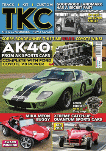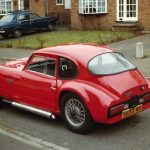THE STORY OF THE ALEXIS GT
I spotted this stunning little GT car in archives recently but initially couldn’t find the notes that I knew should have been with it. It was called the Alexis GT and for a few weeks that was all I knew because I couldn’t find that pesky missing information.
I also looked at my book of words on Alexis Cars but that just confused me more as they only produced trials car and single-seaters for Formula Junior, F100 (single-seater formula for cars powered by Kent Crossflow 1300 engines), FF1600, F3 and F2 between 1959-1976.
They never built a roadcar. Confused? Yes. Then I remembered that Formula Junior guru Duncan Rabagliati had owned this very car for many years, so I fired off an email to him. He was happy to fill in the gaps for me.
Turns out the car used a Buckler Mk V chassis, a Rochdale GT GRP body and an MGA 1500cc engine.
Back to Alexis and their story is very worthy of a quick recap, here.
Founded in 1959 by serial trials car builder, Alex Francis, a building contractor from Ward End, Birmingham along with ex-speedway rider, racing mechanic and designer, Australian, Bill Harris.
Francis had built several Ford 10 specials and some trials cars from the mid-fifties.
Incidentally, the Alexis name came from ‘ALEX’ and the ‘IS’ from either HarrIS or FrancIS, depending on whose story you believe.
With Francis leaning (get it?) on the hills and Harris a circuit racing man, there’s no wonder they catered for trials and single-seaters.
The HF1 (Mk1) was a front-engined Formula Junior car for 1959 and both partners raced it at various times during the season.
In period, the Alexis HF2 was said to be an improvement and Mk3 and Mk4 were rear-engined FJs, with the talented driver Peter Proctor signing on as their works driver for circuit racing and he really helped put them on the map.
The Mk5 was a very capable trials machine and saw them not only become more recognised and accepted as a ‘proper’ manufacturer but between 1961-65 they were the only credible rival in trials to the all-conquering Cannon marque.
It was still pretty small-scale stuff though, which, to be honest, is just the way Francis liked it and until about 1967 they really only built 2 or 3 cars a year, usually selling their works cars at the end of each season.
On the circuits in particular they certainly attracted some talented young (future star) drivers in Americans Roy Pike and Peter Revson (Revlon heir) plus David Hobbs and Paul Hawkins, with the works team almost a separate ‘Team Alexis’ entity. It was Hawkins who scored their best result, victory in the F2 Eifelrennen race at the Nürburgring in 1965.
Late that same year, Bill Harris decided to return home to Australia and Alan Taylor, who had been helping out on an increasingly frequent basis, basically replaced him.
Taylor, a butcher by trade was soon given the reins for the Team Alexis works cars leaving Francis in charge of Alexis Cars, the trials side and customer single-seaters.
Taylor was ever enthusiastic and was the ideal choice to become more heavily involved. If the team needed an extra pair of hands, Taylor had always made himself available.
1967 saw a big change for the company. They recognised early on just how important John Webb’s Formula Ford 1600 idea would become and speculatively built a car for it, the Mk14.
It was without doubt the first car specifically built for FF1600 – sure it looked like the earlier Mk9 F3 car, but it was a very different car mechanically. Rivals were out there. Lotus had the 51, but this really was a revised and design Type 31 1-litre F3 car, while Selwyn Hayward’s Merlyn II was also a revised Merlyn F3 model.
Lotus however had the gig with leading racing school Motor Racing Stables at Brands Hatch. Therefore, Taylor decided to approach their big rivals Jim Russell Driving Development School based at Snetterton circuit.
Russell was impressed with the Mk14 but wanted revisions and a name change to Russell-Alexis Mk14. In total, he bought about 60 of them though, which really helped the Alexis coffers while brought them more widespread recognition
It was a successful arrangement though. 22-year-old Belgian student Claude Bourgoignie won the Formula Ford championship in 1967, while Aussie Dave Walker won the Scottish equivalent in an Alexis (though not a Russell-Alexis note).
Then, in 1968, the Mk15 FF1600 car saw healthy sales of seventy units although the Jim Russell deal ended at the end of that season.
All this extra business was the last thing that Alex Francis wanted though as he was most happy when they were making just three cars a year. What with that and his building company becoming busy resulted in him leaving the company.
Actually, he was going to shut Alexis down but Alan Taylor managed to secure some funding and bought it.
In 1969 they had their best year with 24 Mk18 FF1600s sold, a pair of F100-spec Mk18s and no less than fifty F3 Mk18s made. For a time, they remained based in Francis’ old Ward End premises before a move to Hallaughton Farm, an old cheese dairy in Sutton Coldfield, in 1970.
With Taylor as managing director, Alexis was evolving quickly but they always struggled financially. Taylor employed 10 staff with a new co-director, Doug Christie joining him at the helm and he was in charge of the machine shop and building the FF1600 engines for Team Alexis.
What Taylor should have done in hindsight was put a stop to the Team Alexis works race team and concentrate solely on Alexis Cars, producing customer cars. They’d offer race support at circuits most weekends, along with their own works cars, latterly with Dick Barker behind the wheel.
Taylor was said to be a very generous man and he’d often repair customers’ cars at less than cost. This was a drain on the company’s resources for sure.
The Mk20 was available in three variants F3, Formula B and Formula Atlantic and was quite advanced with tubular monocoque and radiators in the side pots. Alexis fabricated a lot of their own parts in-house (maybe too many) which included their own chassis and exhausts and while they also laminated their own GRP bodies.
They closed their doors for the last time in 1976.











